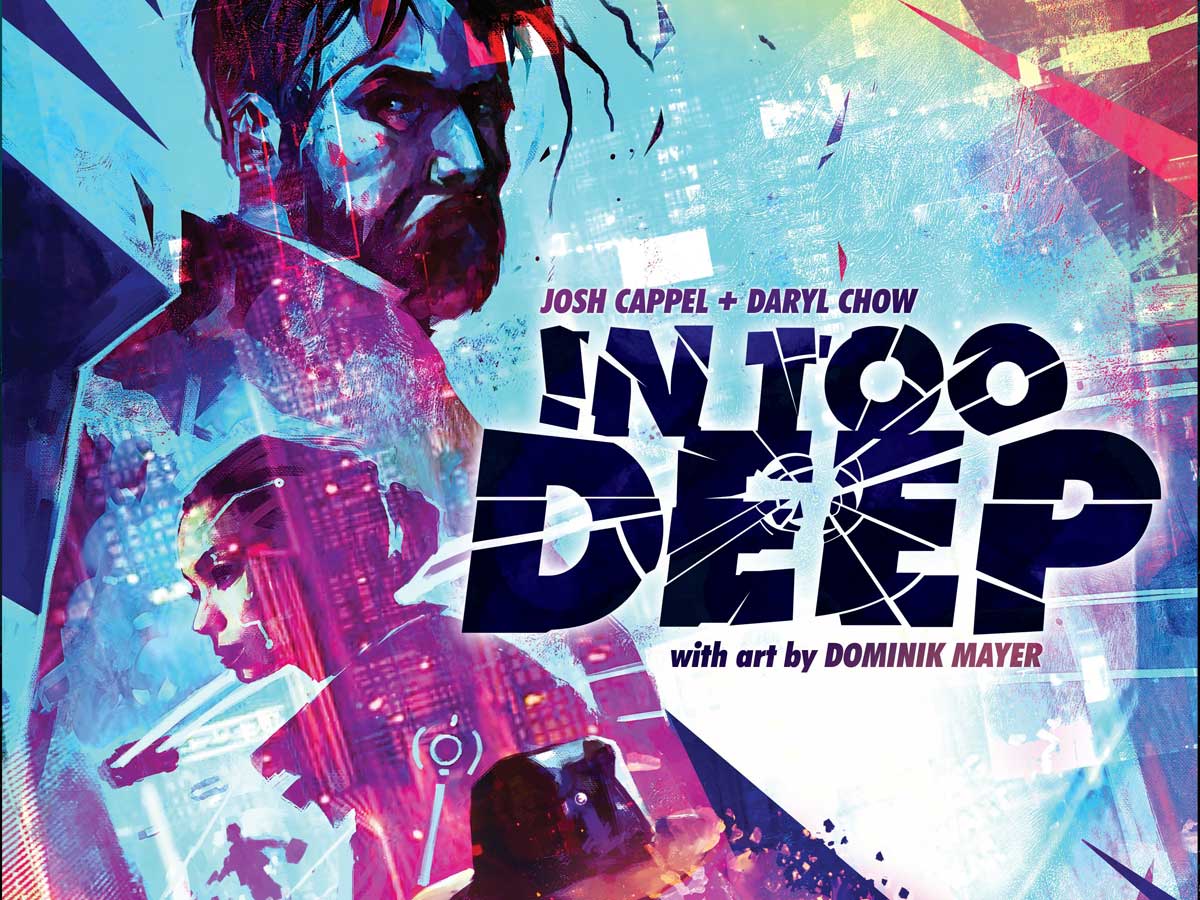Infiltrate the criminal Syndicate and go undercover to foil their plot—but be careful that you don’t go In Too Deep!
What Is In Too Deep?
In Too Deep is a sci-fi game for 1 to 4 players, ages 13 and up, and takes about 90 minutes to play. It’s currently seeking funding on Kickstarter, with a pledge level of $65CAD (about $48USD) for the retail edition or $79CAD (around $58USD) for a copy of the deluxe edition. The theme is about secret agents coordinating various crimes to gather intel, with some implications of violence and illegal activities, so I think the PG-13 rating is probably a good fit.
In Too Deep was designed by Josh Cappel and Daryl Chow and published by Burnt Island Games, with illustrations by Dominik Mayer.
New to Kickstarter? Check out our crowdfunding primer.

In Too Deep Components
Note: My review is based on plays in Tabletop Simulator, so check the Kickstarter campaign for the most up-to-date component lists and images. The final component list may also change due to stretch goals.
Here’s what comes in the game:
- 8 Zone boards
- 53 Crime cards:
- 35 Story Crime cards (15 Level 1, 15 Level 2, 5 Level 3)
- 17 Side Crime cards
- Syndicate board
- Evidence board
- 72 Dilemma cards
- 4 Player mats
- 6 Criminals, each with:
- Criminal standees
- Hook Tag token
- Grip disc
- 72 Evidence tokens (12 each in 6 types)
- 30 Boost tokens
- 8 Item tiles
- Sentinel Pawn
- 6 Heat markers
- 2 Blockade tokens
- 6 Assignment tokens
- 9 Contribution cubes
- 16 Tolerance tokens
- Chapter marker
- Intel chits (in denominations of 1, 5, 10, 20, 50)
- 15 Echo cards (for solo play)
The deluxe edition will include:
- 6 Criminal miniatures (instead of standees)
- 6 Colored bases
- Sentinel Miniature

I’ve played the game over Tabletop Simulator so far so I’ve only seen a digital version of the components, but I do like what I see. The illustrations by Dominik Mayer on the location tiles and cards are a good fit for the theme—sort of a Blade Runneresque world with high-tech criminals. The models for the plastic miniatures in the deluxe edition (not pictured in my screenshots) were sculpted by Francesco Orru and look fantastic: the Dronejack has some sort of huge VR helmet, the sprinter has spring-loaded robot legs, and so on.
There’s a lot of iconography used, from the boost tokens to the location boards—some of it seems obvious without much experience, and others I had to keep checking the reference card. Having the tactile components may make a difference for that, but there’s definitely a lot of different things to keep track of.
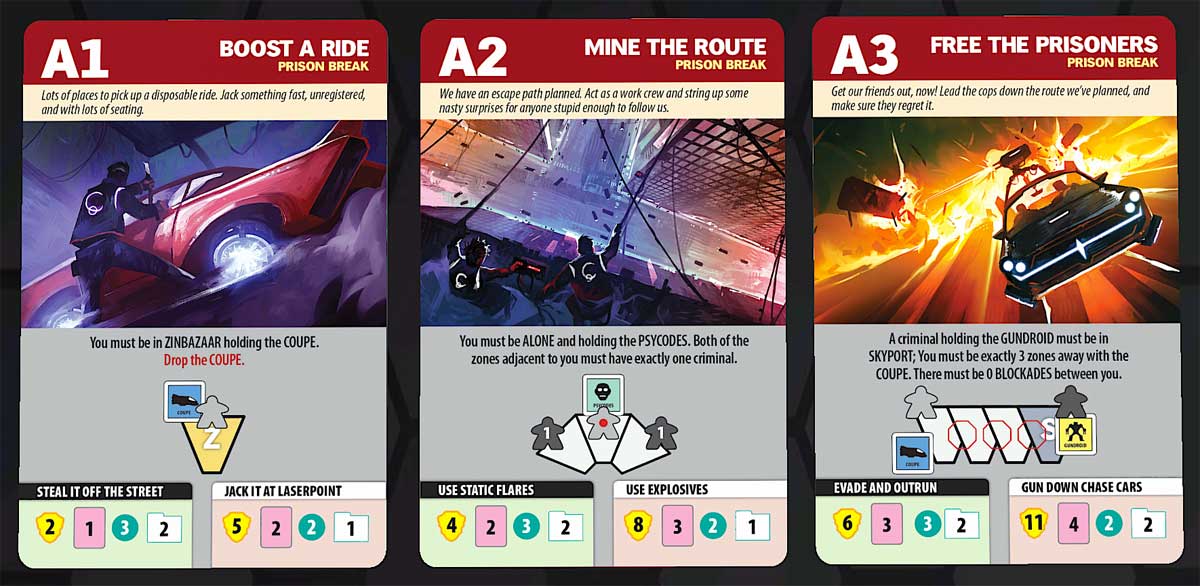
The crime cards have evocative titles, with a little bit of flavor text to help flesh out the story. The story crimes have two options for rewards, which are also labeled with descriptions to help immerse you in the theme: do you want to “kick a few doors in” or “bust some heads”? Should you “forge new docs” or “frame an innocent tech”?
How to Play In Too Deep
You can download a draft of the rulebook here.
The Goal
The goal of the game is to gain the most intel, but there may be consequences for having too much corruption.
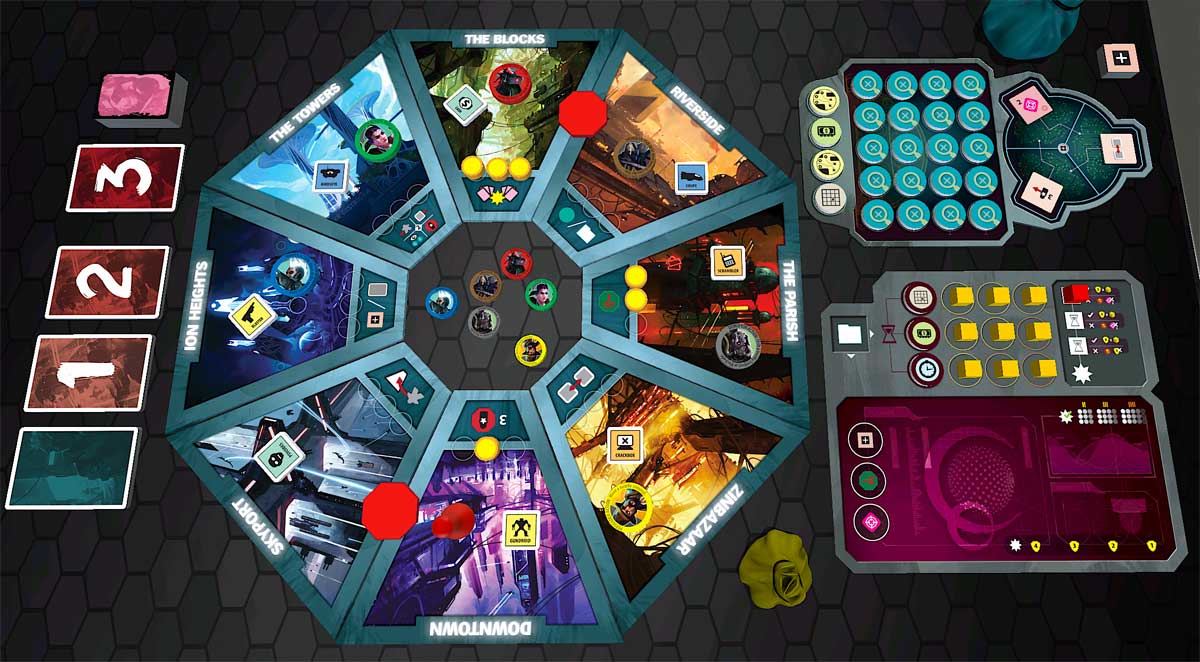
Setup
Set up the zone boards randomly to form an octagonal ring. Randomly place 1 item in each zone and the Sentinel in Downtown. Place 1 blockade on the clockwise edge of Downtown, and the other on the opposite side of the city. Choose criminals (5 or 6 depending on player count) and place them randomly in different zones, not with the sentinel. Place their hook tag tokens in the center of the city. Put 3 heat in the Blocks, 2 heat two zones clockwise, and 1 heat two more zones clockwise.
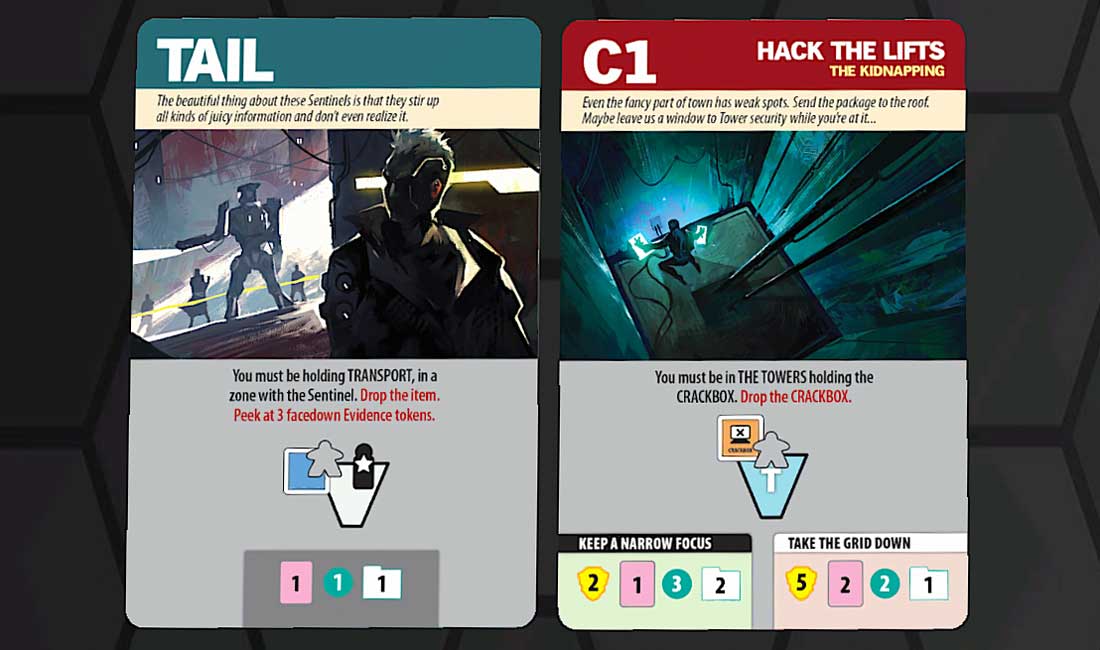
Shuffle the four crime decks separately (the 3 levels and the side crimes) and place them face-down nearby. Deal each player a Level 1 crime and a side crime. Shuffle the dilemma cards and place them face-down. Place intel chits and tolerance tokens in a supply.

Put the evidence board and the syndicate board near the city. Mix up the evidence tokens. Draw 4 to place face-up on the “plank” on the edge of the evidence board, and then fill the pool on the board with face-down tokens based on the number of players. Shuffle the boost tokens and place 1 face-up on each of the display spots.

Shuffle the assignment tokens and draw three to place onto the syndicate board on the assignment spots. place contribution cubes on the spaces according to the player count. Place the chapter marker on the top space of the chapter track.
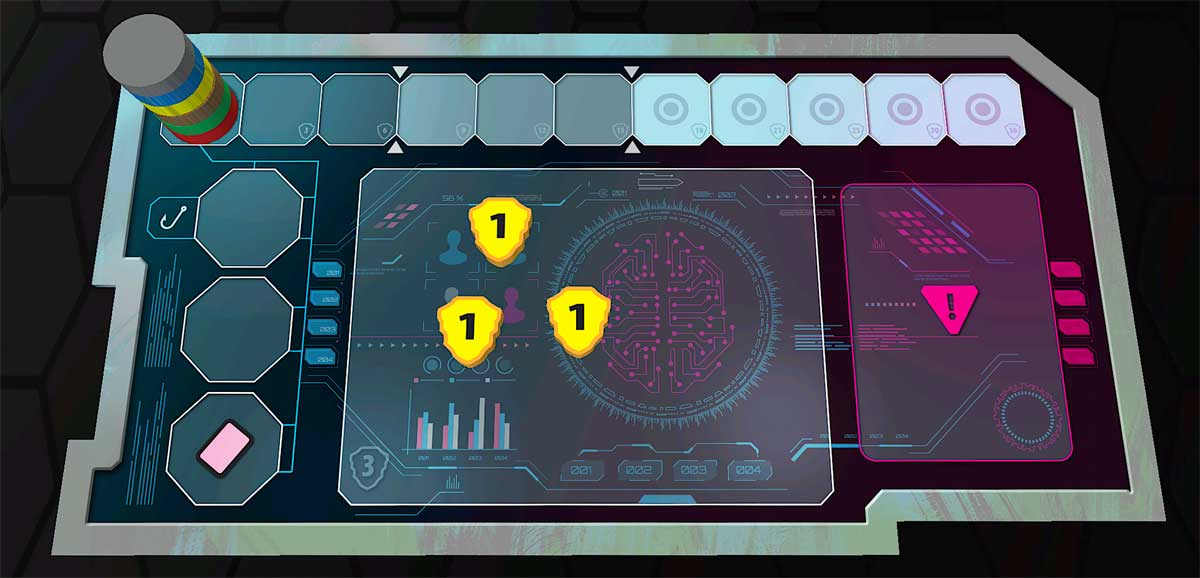
Give each player a player mat and 1 grip disc for each of the criminals, which are stacked on the lowest space of the grip track. Each player takes 1 random evidence token from the supply (kept hidden from other players) and 3 intel. Choose a start player; other players will gain grip (moving a grip token to the right on the track) based on turn order.
Gameplay
Normally, I don’t say too much about the theme of the game in the “How to Play” section, but in this case I think it would help since there’s a sci-fi element that helps the actions make more sense. The Syndicate is a group of cyber-enhanced criminals, and your agency has figured out a way to hack into these criminals’ minds, observing their activities and even influencing them to some extent as they pull off their crimes. You “hook” into a criminal, and the more time you spend in their mind, the more “grip” (influence) you have over them. You are collecting intel (points), but also gathering and filing evidence of 6 different types—evidence can be filed toward the current chapter, or toward the final plot, with different effects. As the crimes are committed, you also gain dilemma cards, which provide both potential intel and corruption. At the end, you score for intel, but you might also lose points for having the most corruption.
On your turn, you do the following:
- Hook
- Gain Grip
- Perform Actions (optionally complete side crimes)
- Complete a Story Crime
- Ditch and Draw Cards
Hook
You may unhook from any of your current criminals, putting their hook tags back into the center pool. The you may hook 1 criminal: take the hook tag and put it on your board. If the criminal was taken from another player, pay them 1 intel. If this is your third criminal (the maximum), you must draw a dilemma card.
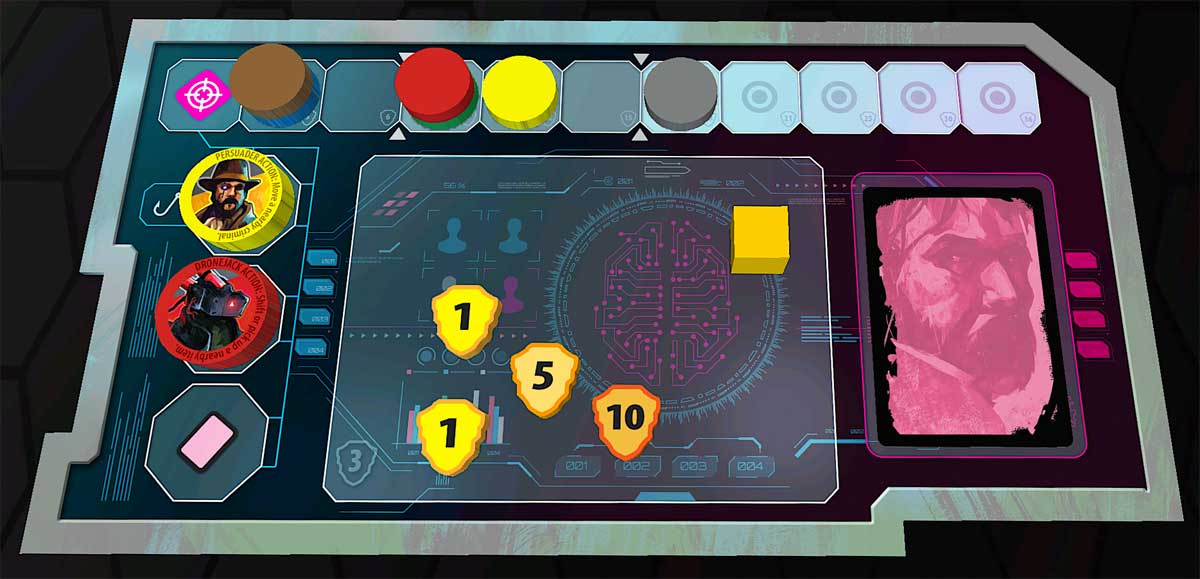
Gain Grip
For each criminal you’re currently hooked into, slide the corresponding grip disc 1 space to the right. When you reach the 4th space of the track, you may use that criminal’s special power (when you are hooked into them). When you reach the 7th space of the track, you may spend grip for additional actions with that criminal. Your lowest grip disc will also be worth points at the end of the game.
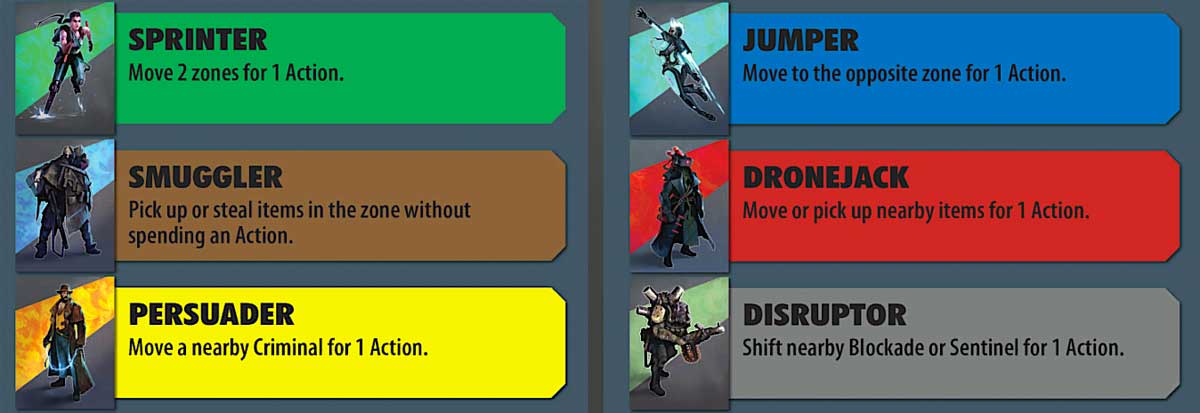
Perform Actions
You have 2 actions to use with any of the criminals currently under your control. You may:
- Move 1 space clockwise or counterclockwise, not through blockades
- Pick up an item in your space that isn’t currently held by another criminal. Each criminal can only hold 1 item at a time, and dropping items does not cost an action.
- Use a zone ability if there is no heat in your zone. More details below.
- Use a Criminal Skill if you have sufficient grip.
- Gain 1 Grip with any criminal you’re currently hooked into.
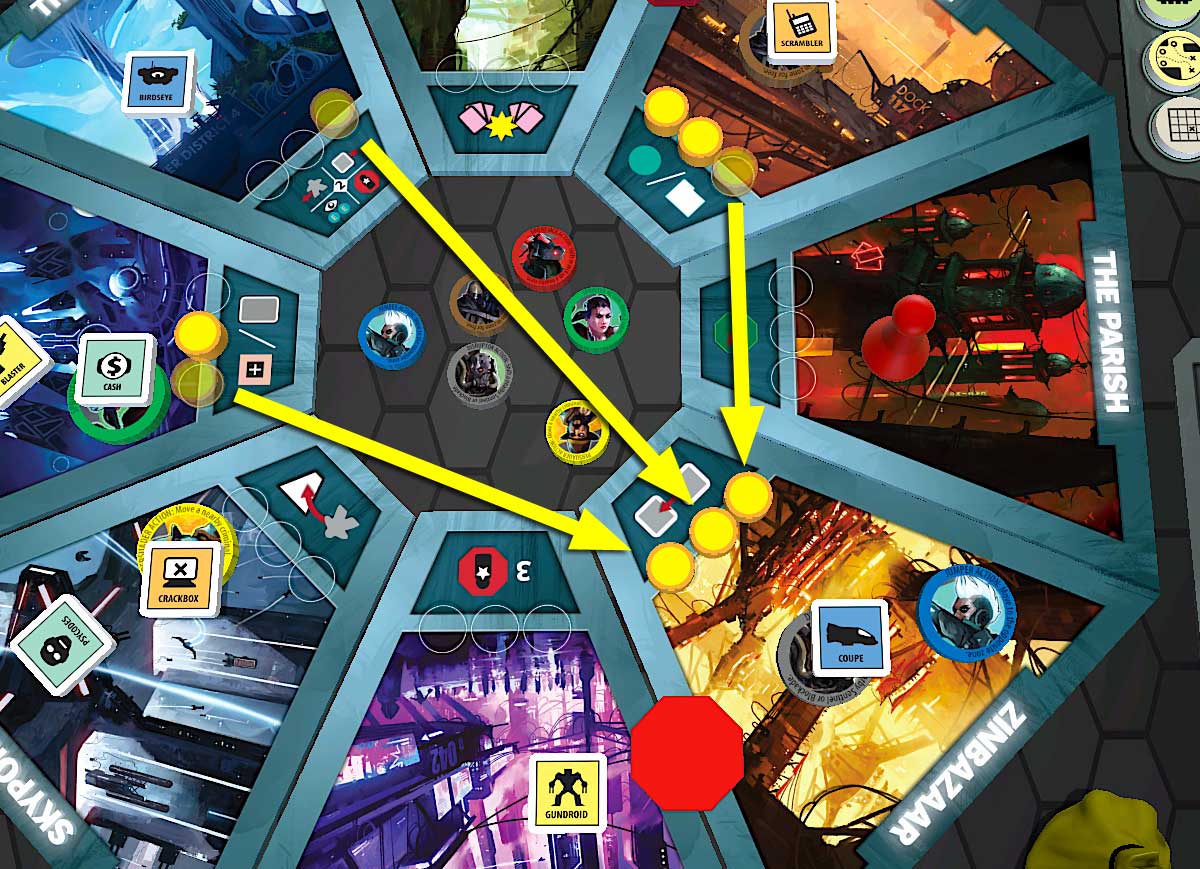
When you use a zone ability, it attracts the attention of the police. Move 1 heat from each of the three zones that have heat to your zone. Effectively this means there’s a cooldown timer for a zone’s ability, preventing it from being used until heat is drawn to other zones. Each zone has its own ability, from moving a criminal with the Skyport to swapping items at Zinbazaar to gaining a little tolerance to cover your corruption at the Parish.
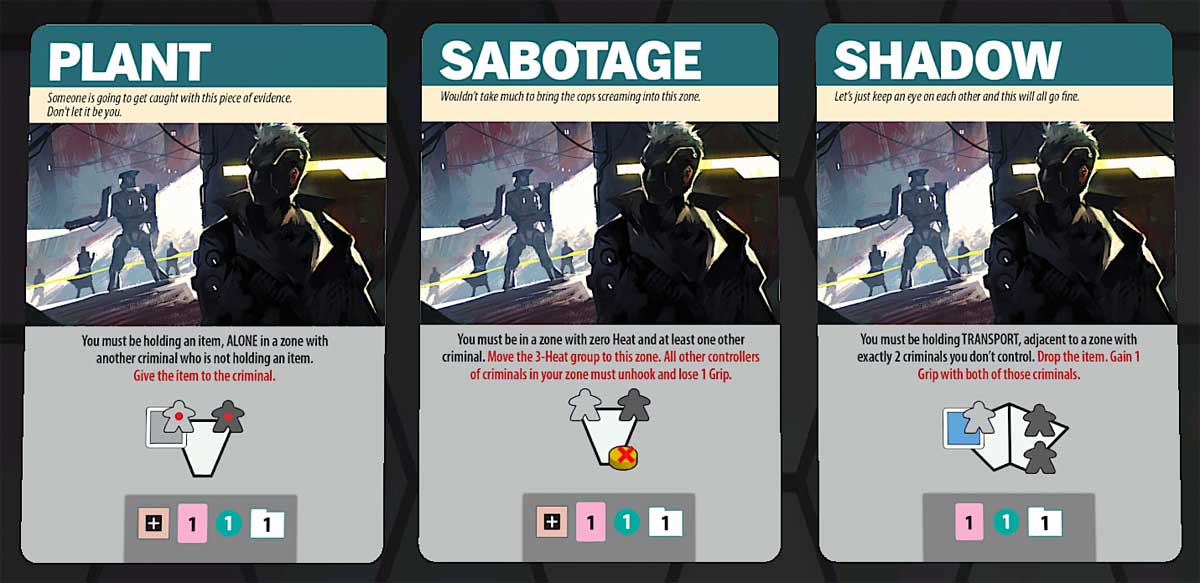
If at any time during this phase you fulfill the conditions on a side crime, you may complete it. Reveal the card to show that you’ve met the conditions. Follow the instructions in red text (if any). Then take the reward at the bottom, which will give you some combination of boosts, intel, evidence, and dilemma cards, and may also let you file an evidence. Discard the card.

Complete a Story Crime
Completing a story crime is similar to the side crime: you must fulfill the conditions on the card by maneuvering criminals, items, the Sentinel, and blockades into certain configurations. With story crimes, the prerequisites must also be met: each card has a letter and a number, like B2. Level 2 crimes may not be completed until the corresponding Level 1 has been completed, so C1 must come before C2, but it doesn’t matter who completed C1.
Reveal the card, follow the text in red, and then choose one of the two rewards. The one on the left is generally a little more restrained, doing less damage: you’ll get less intel and fewer dilemmas, but file more evidence. The one on the right is more villainous: you’ll gain more intel and more dilemmas, but file less evidence.
Once completed, place the card face-up, making a shared display on the table so that everyone can see which crimes have been completed.
Then, unhook from all of your criminals, placing their hook tags back in the center pool.
Ditch and Draw Cards
You may discard any number of crime cards, placing them at the bottom of their decks. Then, draw back up until you have at least 1 side crime and 1 story crime, if needed. You may draw from any level of story crimes, but keep in mind that you can’t complete higher levels if the prerequisites have not been met.

When you file evidence, you place it either in the chapter area or the final plot area. In the chapter area, you must match the assignment token, and you may file it in a space that has a contribution cube, taking the cube for yourself. If all cubes are taken by the end of the chapter, then each cube is worth points. If not all cubes are taken by the end of the chapter, then players who have no contribution cubes will suffer a penalty.
If you file into the final plot, you place it face-down. Evidence filed here will be revealed at the end to show whether the final plot was foiled, and will also determine the point value of evidence still held by players at the end of the game. There are also three bonuses you can gain for filing evidence here if the spaces are still available.
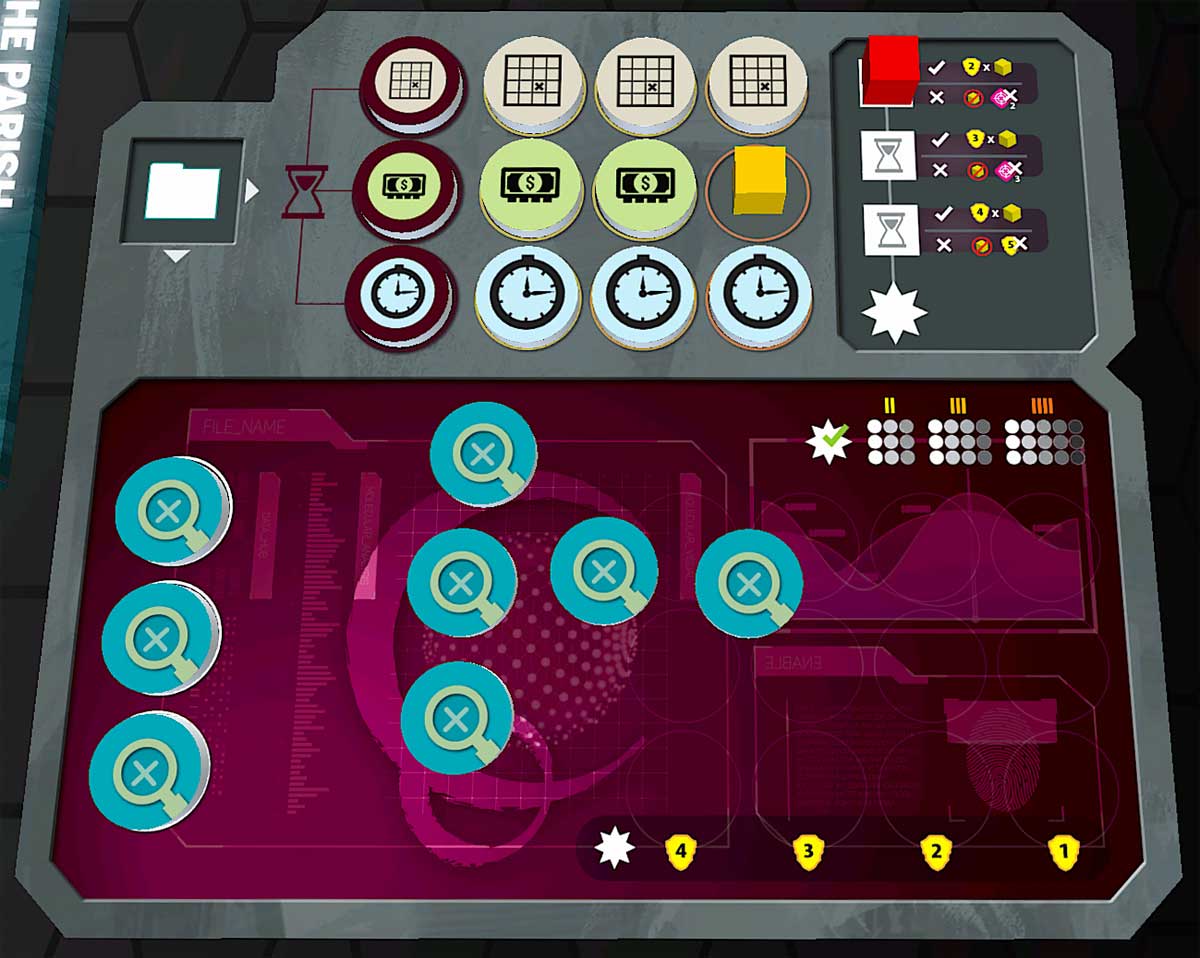
Chapter End and Game End
There are three chapters. Each chapter ends when there’s not enough evidence to refill the evidence plank. At that point, you check for contribution rewards or penalties, and then reset the chapter grid by reshuffling the assignments and refilling it with the cubes.
Every player also has to put half (rounded up) of their dilemma cards face-down into their permanent bank on their player board, discarding the rest face-down.
Then the evidence board is refilled for the next chapter.
At the end of the third chapter, you move to final scoring.
First, you score intel based on your lowest grip disc, as shown on the grip track.

Then, you reveal dilemma cards. Add up all of your corruption, and then subtract 2 for each tolerance token you have. The player with the highest corruption went “in too deep.” The player with the least corruption gets 5 intel for each player with higher corruption.
Check to see if the final plot was foiled: reveal all the evidence in the final plot area. There must be a number of sets of three in order to foil the plot, based on the player count. For instance, with 2 players, you need 3 sets of 3. If the plot was foiled, the player who went in too deep loses intel equal to their corruption. If the plot was not foiled, there’s no penalty.
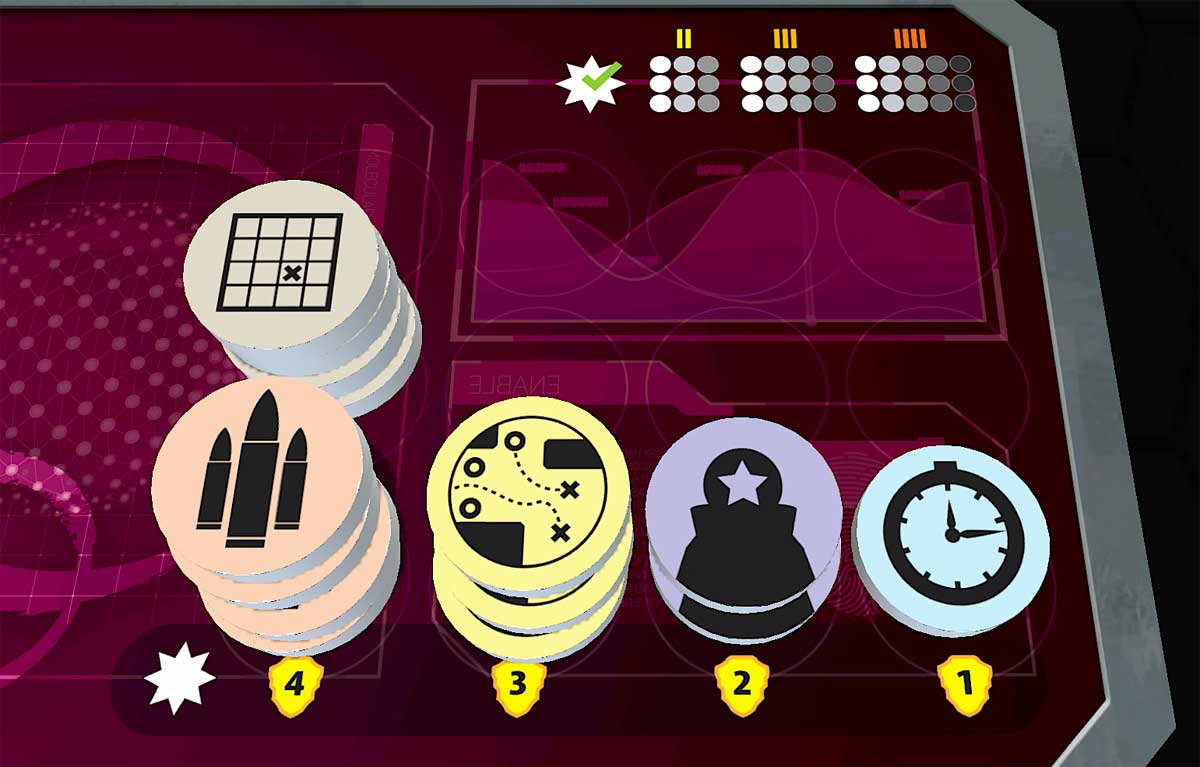
You then score for evidence and dilemma cards. The evidence in the final plot area is grouped so you can see which evidence there’s the most of, second most of, etc. That determines the intel value of evidence that the players have, whether as evidence tokens or printed on their dilemma cards. (Evidence types that were not filed at all into the final plot area are not worth anything!)
Some dilemma cards have other types of scoring—there are wanted posters, sentinel sigils, and intel points printed on the cards.
The player with the highest total score wins, with ties going to the player with least corruption. The rulebook also provides a thematic explanation of what happened depending on whether the winner went in too deep and whether the final plot was foiled.

Why You Should Play In Too Deep
In Too Deep feels like a cross between The Departed and Blade Runner—you’re essentially posing as criminals by hacking into their brains, nudging them along in their schemes to gather intel, but each illegal act pulls you in a little further into their world. The story crimes kind of tell a story as they play out, building up from one level to the next. It’s not always the same people involved in each step, giving you the feel of a crew coordinating their actions, dropping in and out as needed.
Of course, in the game, the crew is not always coordinated, because there are multiple masterminds vying for control over the same group of criminals. One player is trying to set up a hit, and another is planning a prison break, and both of you are fighting over where the items should be. It’s not two competing crews going after the same heist—it’s a problem of too many generals and not enough soldiers.
And that’s the crux of the game: trying to get people and items in place for the crimes, hopefully without making things any easier for your rivals. That happens occasionally, too. You’re planning to get the Sprinter to Ion Heights to pick up the psycodes, but somebody else just needed a warm body there and happened to move the Sprinter—excellent! The more players there are, the more unpredictable things can get. You can make some tentative plans while you’re waiting, but quite often you can’t finalize anything until your turn rolls around because the state of the board can change so quickly.
I really enjoyed the challenge of manipulating the board and setting up the crimes, though I know some players felt it was a little too chaotic with more players. For me, it’s particularly satisfying when you can execute a side crime and a story crime in the same turn, lining everything up just right. You know I like games that involves puzzles, and In Too Deep often feels like one. Since whatever you do on your turn might be undone by another player, it’s hard to set things up over the course of a few turns, so the game pushes you to figure out a solution that gets you to a crime with your 2 actions. Good thing you have a few tricks up your sleeves.

One of those tricks is the boost tokens—you can acquire these by completing side crimes or by using the zone ability of Ion Heights. Some boosts have an immediate effect, but there are several that can be saved and used later, and they don’t take an action to use. They have powerful effects like hooking another criminal, moving heat from a zone so you can use its ability right away, or locking a criminal so nobody can hook it away from you. If you can’t get to your story crime on your turn, you’re sometimes better off pursuing the side crime simply to get a boost token for later use.
Another trick is the criminal abilities, which can make setting up a crime much easier. The Sprinter can move more quickly, and the Jumper can leap to the opposite side of the city. The Smuggler can grab items from an adjacent location. While it may not seem like you’re accomplishing much by using an action or two to gain grip, hitting that ability threshold unlocks the abilities. Gain enough grip, and you can just buy yourself additional actions, too—another way to make the most of your turns.
The crimes themselves sometimes have effects when you pull them off, moving things around, causing other players to lose grip, and so on. Don’t be afraid to ditch your current crime card and draw a new one, because maybe you’ll find one that’s easier to arrange, or has some effects that can help you. You can also gamble and take a higher level card even if not all of the Level 1 crimes have been committed, hoping that you’ll get one that already has its prerequisites met, or that somebody will get it done before your turn comes around again. Higher level crimes have bigger rewards, but are also significantly harder to achieve.

And, of course, there are the zone abilities. Depending on where things are, you can use zone abilities to move criminals or items, rearrange blockades, gain evidence, or buy yourself some tolerance to mitigate corruption. The Sentinel—which seems like a bit of a misnomer as it doesn’t typically do anything to the criminals—can escort a criminal through a blockade, and there are a few ways to gain control of the Sentinel.
Your motivation for setting up the crimes, of course, is to get intel and evidence. This part of the game can get a little complicated and there’s a lot going on there, with a bit of press your luck, too. Filing evidence to the chapter section might be worth points, but only if all of the contribution cubes are claimed. So if you’re the only one filing evidence there, chances are you’ll get a lot of cubes, but they’re worthless. On the other hand, if the cubes aren’t all taken, then players who have no cubes suffer a penalty, so usually everyone wants at least one cube—which then may turn into a race to get more than the other players.
Filing evidence to the final plot, on the other hand, has a couple of benefits as well: first, there are three bonus spaces that can each be used once per chapter when filing evidence, giving you a boost, tolerance, or grip. Also, the evidence here indicates whether the final plot is foiled, and thus whether the player who went in too deep will lose points. This makes for some fun mind games: can you afford to take more dilemma cards because you know the plot won’t be foiled? Should you file more evidence because you think another player has more corruption than you? Finally, the evidence in this section determines the point value of the evidence you’ve hoarded for yourself. That can be tricky, because if you file a lot of one type to make it worth more points, then you don’t have as much of it left to score those points.
There are some ways to peek at evidence, which can get you some more information. I don’t tend to use those as much myself simply because my memory isn’t great and I forget which ones I’ve already looked at, plus it’s mostly useful if you can look at enough of them to get an overall picture. Looking at just two of them may not really give you an indication of whether the final plot is going to be foiled or not.
I’ve been excited for In Too Deep since I first heard about it, and although I didn’t get a chance to play a physical prototype (which wouldn’t work really well currently because of quarantine), I’m glad I got a chance to check out the digital version. I really enjoy the puzzle of getting everything into the right place, as well as the immersive theme of the game, but you have to be okay with other players often interfering with your plans. I can’t wait to see how the finished game turns out, so I hope the campaign achieves its funding goals.
For more information or to make a pledge, visit the In Too Deep Kickstarter page!
Click here to see all our tabletop game reviews.
![]() To subscribe to GeekDad’s tabletop gaming coverage, please copy this link and add it to your RSS reader.
To subscribe to GeekDad’s tabletop gaming coverage, please copy this link and add it to your RSS reader.
